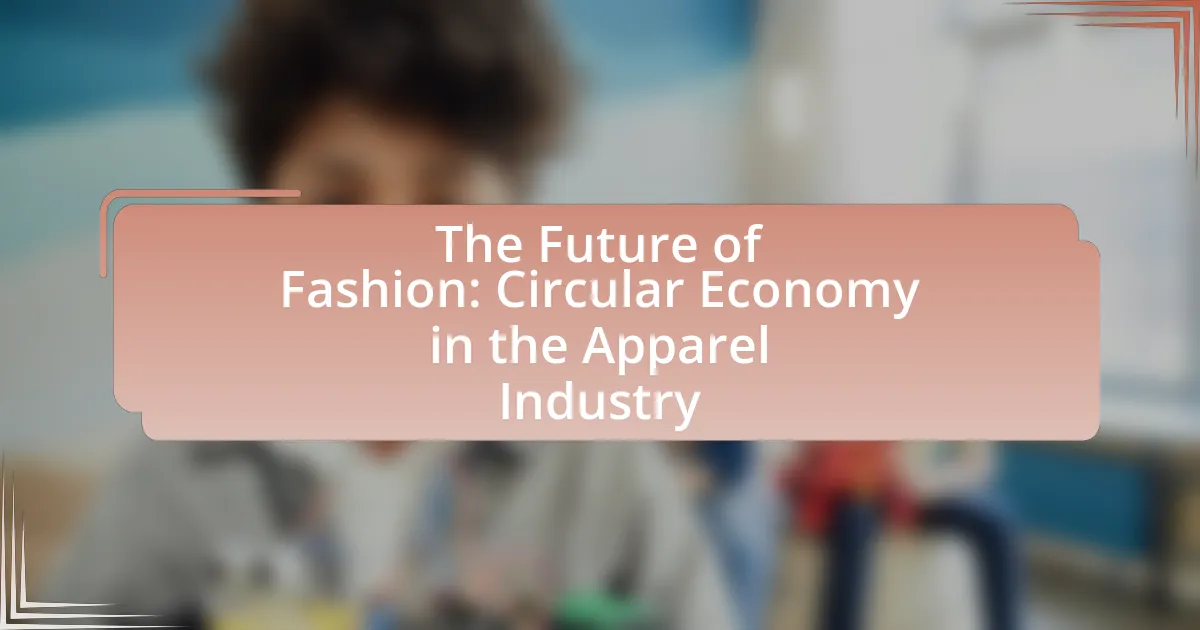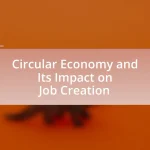The article focuses on the Circular Economy in the Apparel Industry, a sustainable model that promotes the continuous use of resources through product design aimed at longevity, reuse, and recycling. It contrasts with the traditional linear economy, which generates significant waste and environmental degradation. Key principles of the circular economy include waste reduction, resource efficiency, and the use of sustainable materials, which can significantly lower greenhouse gas emissions and mitigate the environmental impacts of fashion. The article also explores the challenges and opportunities brands face in adopting circular practices, the role of consumer behavior, and successful initiatives that exemplify circular fashion.
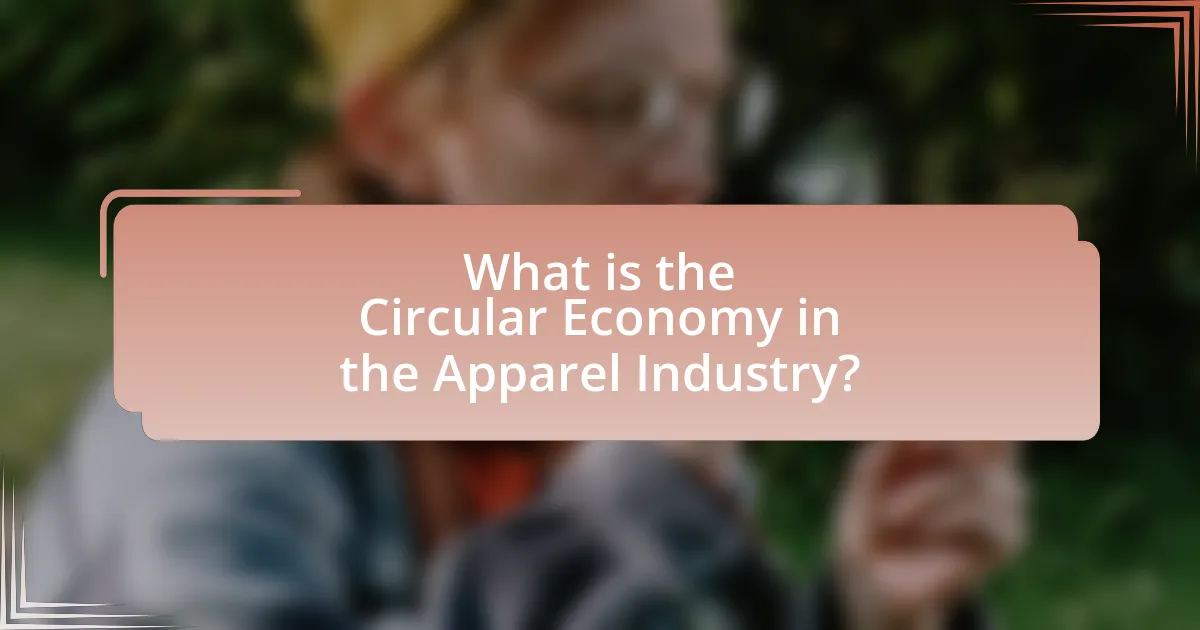
What is the Circular Economy in the Apparel Industry?
The Circular Economy in the Apparel Industry is a sustainable model that emphasizes the continuous use of resources by designing products for longevity, reuse, and recycling. This approach contrasts with the traditional linear economy, which follows a ‘take-make-dispose’ pattern. In the circular economy, brands focus on reducing waste and environmental impact by implementing practices such as using biodegradable materials, promoting second-hand markets, and encouraging consumers to return used garments for recycling. According to the Ellen MacArthur Foundation, transitioning to a circular economy in fashion could reduce greenhouse gas emissions by 44% by 2030, highlighting its potential for significant environmental benefits.
How does the circular economy differ from the traditional fashion model?
The circular economy differs from the traditional fashion model by prioritizing sustainability and resource efficiency over linear consumption. In the traditional model, fashion operates on a “take-make-dispose” basis, leading to significant waste and environmental degradation, with the Global Fashion Agenda reporting that the industry generates 92 million tons of waste annually. Conversely, the circular economy emphasizes the reuse, recycling, and regeneration of materials, aiming to minimize waste and extend the lifecycle of products. This approach not only reduces environmental impact but also fosters economic resilience by creating new business opportunities in repair, resale, and recycling sectors.
What are the key principles of the circular economy?
The key principles of the circular economy include designing for longevity, maintaining product value, and minimizing waste. Designing for longevity involves creating products that are durable and can be easily repaired, which extends their lifecycle. Maintaining product value focuses on keeping materials in use through reuse, refurbishment, and recycling, thereby reducing the need for new resources. Minimizing waste emphasizes the importance of reducing waste generation at every stage of the product lifecycle, from production to disposal. These principles aim to create a sustainable system that benefits both the environment and the economy by promoting resource efficiency and reducing environmental impact.
How does waste reduction play a role in the circular economy?
Waste reduction is a fundamental component of the circular economy as it minimizes resource consumption and environmental impact. In the context of the apparel industry, implementing waste reduction strategies, such as designing for longevity and promoting recycling, directly contributes to a more sustainable production cycle. For instance, the Ellen MacArthur Foundation reports that the fashion industry could reduce its greenhouse gas emissions by 44% by 2030 through circular practices, including waste reduction. This demonstrates that effective waste management not only conserves resources but also enhances economic efficiency and sustainability within the circular economy framework.
Why is the circular economy important for the future of fashion?
The circular economy is crucial for the future of fashion because it promotes sustainability by minimizing waste and maximizing resource efficiency. This model encourages the design of products that can be reused, repaired, or recycled, significantly reducing the environmental impact of the fashion industry, which is responsible for approximately 10% of global carbon emissions. By adopting circular practices, brands can enhance their resilience against resource scarcity and shifting consumer preferences towards sustainable products, ultimately leading to a more sustainable and economically viable fashion ecosystem.
What environmental impacts does the fashion industry currently face?
The fashion industry currently faces significant environmental impacts, including high levels of water consumption, pollution, and waste generation. For instance, the production of a single cotton t-shirt requires approximately 2,700 liters of water, which is enough for one person to drink for two and a half years. Additionally, the industry is responsible for about 20% of global wastewater, primarily due to the dyeing and finishing processes that release toxic chemicals into water bodies. Furthermore, the fashion sector contributes to around 10% of global carbon emissions, exacerbating climate change. These statistics highlight the urgent need for sustainable practices within the industry to mitigate its detrimental effects on the environment.
How can the circular economy mitigate these impacts?
The circular economy can mitigate the negative impacts of the apparel industry by promoting resource efficiency and waste reduction. By designing products for longevity, reuse, and recycling, the circular economy minimizes the extraction of raw materials and reduces landfill waste. For instance, a study by the Ellen MacArthur Foundation found that adopting circular practices could reduce greenhouse gas emissions from the fashion industry by 44% by 2030. This approach not only conserves resources but also encourages sustainable consumption patterns, ultimately leading to a more resilient and environmentally friendly fashion ecosystem.
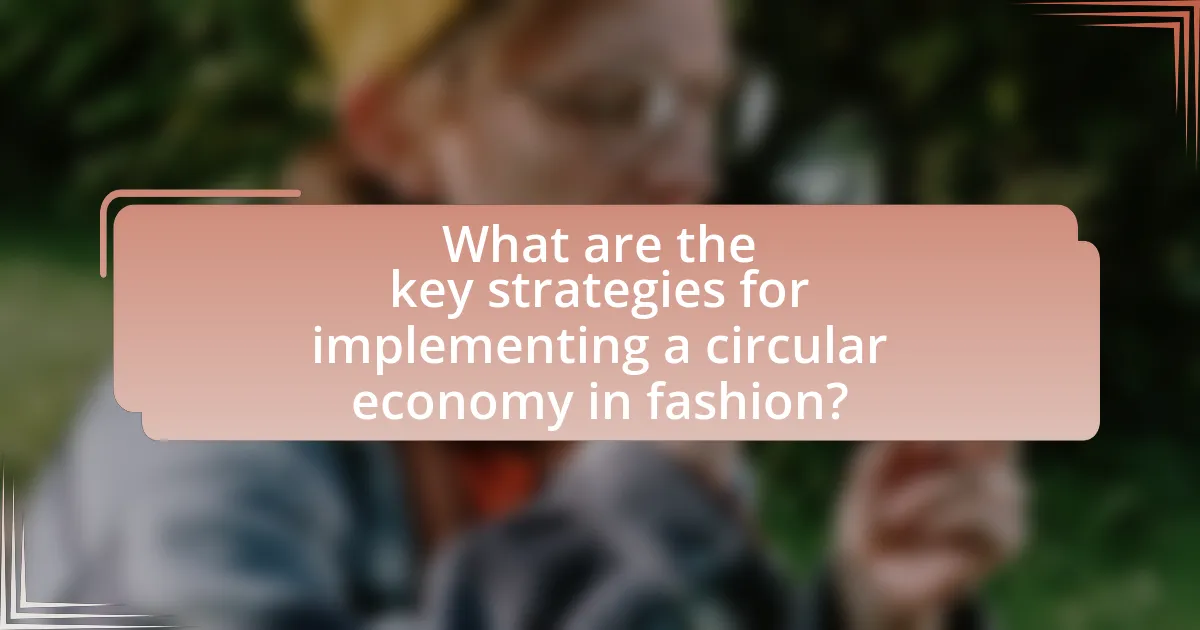
What are the key strategies for implementing a circular economy in fashion?
Key strategies for implementing a circular economy in fashion include designing for longevity, utilizing sustainable materials, and establishing take-back programs. Designing for longevity involves creating garments that are durable and timeless, reducing the need for frequent replacements. Utilizing sustainable materials, such as organic cotton or recycled polyester, minimizes environmental impact and resource depletion. Establishing take-back programs encourages consumers to return used clothing for recycling or resale, thereby closing the loop in the production cycle. These strategies collectively contribute to reducing waste and promoting sustainability in the fashion industry.
How can brands adopt sustainable materials in their production processes?
Brands can adopt sustainable materials in their production processes by integrating eco-friendly fabrics, such as organic cotton, recycled polyester, and Tencel, into their supply chains. This shift not only reduces environmental impact but also meets consumer demand for sustainable products. For instance, organic cotton uses 91% less water than conventional cotton, significantly lowering water consumption in textile production. Additionally, brands can collaborate with suppliers who prioritize sustainable practices, ensuring that the entire production process aligns with eco-friendly standards. Implementing life cycle assessments can further help brands evaluate the environmental impact of materials and make informed decisions.
What types of sustainable materials are available for apparel production?
Sustainable materials available for apparel production include organic cotton, Tencel (lyocell), hemp, recycled polyester, and bamboo. Organic cotton is grown without synthetic pesticides or fertilizers, reducing environmental impact. Tencel, made from sustainably sourced wood pulp, is biodegradable and produced in a closed-loop process that recycles water and solvents. Hemp requires minimal water and no pesticides, making it an eco-friendly option. Recycled polyester, derived from post-consumer plastic bottles, diverts waste from landfills and reduces reliance on virgin materials. Bamboo grows rapidly and requires less water, while its processing can be environmentally friendly when done correctly. These materials contribute to a more sustainable apparel industry by minimizing resource consumption and waste.
How do these materials affect the lifecycle of clothing?
Materials significantly influence the lifecycle of clothing by determining its durability, environmental impact, and recyclability. For instance, natural fibers like organic cotton and hemp are biodegradable, reducing landfill waste, while synthetic fibers such as polyester can take hundreds of years to decompose, contributing to environmental pollution. Additionally, the choice of materials affects the energy and resources required during production; for example, producing recycled polyester uses 59% less energy compared to virgin polyester, thereby lowering carbon emissions. Furthermore, the recyclability of materials, such as those designed for circular fashion, enhances the potential for reuse and reduces the overall lifecycle impact of clothing.
What role does consumer behavior play in the circular economy?
Consumer behavior plays a crucial role in the circular economy by influencing demand for sustainable products and practices. When consumers prioritize eco-friendly options, they drive companies to adopt circular practices such as recycling, upcycling, and sustainable sourcing. Research indicates that 66% of global consumers are willing to pay more for sustainable brands, demonstrating a clear market preference for environmentally responsible choices. This shift in consumer preferences encourages businesses in the apparel industry to innovate and implement circular economy principles, ultimately reducing waste and promoting resource efficiency.
How can consumers contribute to a circular fashion system?
Consumers can contribute to a circular fashion system by actively participating in sustainable practices such as buying second-hand clothing, recycling garments, and supporting brands that prioritize circularity. By choosing to purchase from thrift stores or online resale platforms, consumers extend the lifecycle of clothing, reducing waste and resource consumption. Additionally, recycling textiles helps divert materials from landfills, with the global textile recycling market projected to reach $5 billion by 2027, indicating a growing recognition of its importance. Supporting brands that implement circular business models, such as take-back programs or sustainable sourcing, further encourages the industry to adopt practices that minimize environmental impact.
What are the challenges consumers face in adopting circular practices?
Consumers face several challenges in adopting circular practices, primarily including lack of awareness, limited access to sustainable options, and perceived inconvenience. Many consumers are not fully informed about the benefits of circular practices, which hinders their willingness to engage in sustainable behaviors. Additionally, sustainable products are often less accessible in mainstream markets, making it difficult for consumers to choose circular options. Furthermore, the perception that circular practices, such as recycling or upcycling, require more effort or time than traditional disposal methods discourages participation. These challenges are supported by research indicating that consumer education and accessibility are critical factors in promoting sustainable behaviors in the apparel industry.
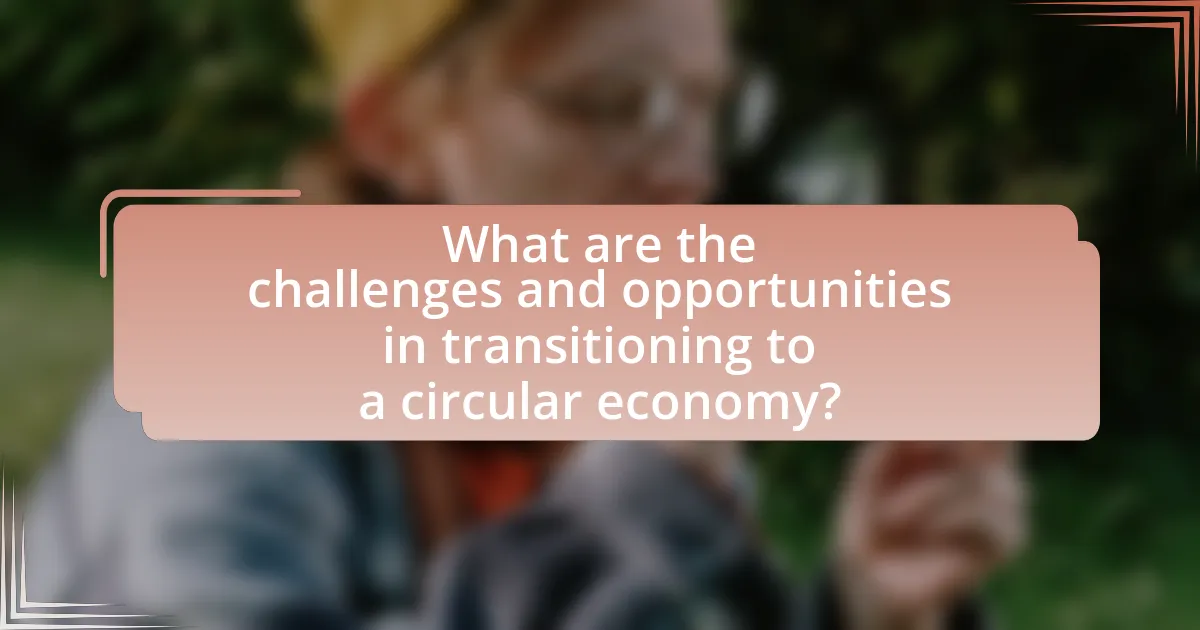
What are the challenges and opportunities in transitioning to a circular economy?
The challenges in transitioning to a circular economy include the need for significant changes in production processes, consumer behavior, and supply chain management. For instance, manufacturers must invest in new technologies and materials that support recycling and reuse, which can be costly and complex. Additionally, consumer awareness and demand for sustainable products are still developing, making it difficult for companies to justify the transition financially.
Opportunities in this transition involve the potential for innovation and new business models that prioritize sustainability. Companies can tap into growing consumer interest in eco-friendly products, which can lead to increased market share and brand loyalty. According to a report by the Ellen MacArthur Foundation, transitioning to a circular economy could generate $4.5 trillion in economic benefits by 2030, highlighting the financial incentives for businesses to adopt circular practices.
What obstacles do brands encounter when shifting to circular practices?
Brands encounter several obstacles when shifting to circular practices, including high initial costs, lack of infrastructure, and consumer awareness challenges. High initial costs arise from the investment needed for sustainable materials and technologies, which can deter brands from making the transition. The lack of infrastructure, such as recycling facilities and supply chain adaptations, complicates the implementation of circular systems. Additionally, consumer awareness challenges exist, as many consumers may not understand or prioritize circular practices, making it difficult for brands to justify the shift. According to a report by McKinsey & Company, 60% of consumers are not aware of circular economy concepts, highlighting the need for education and engagement in this area.
How can brands overcome these challenges?
Brands can overcome challenges in the circular economy by implementing sustainable practices, such as using recycled materials and designing for longevity. For instance, adopting a closed-loop system allows brands to recycle old garments into new products, reducing waste and resource consumption. According to a report by the Ellen MacArthur Foundation, transitioning to a circular economy in fashion could generate $560 billion in economic benefits by 2030. Additionally, brands can engage consumers through education on sustainable practices, fostering a culture of responsible consumption. This approach not only addresses environmental concerns but also enhances brand loyalty and market competitiveness.
What role do regulations play in facilitating this transition?
Regulations play a crucial role in facilitating the transition to a circular economy in the apparel industry by establishing standards and guidelines that promote sustainable practices. These regulations can mandate the reduction of waste, encourage recycling, and incentivize the use of eco-friendly materials. For instance, the European Union’s Circular Economy Action Plan aims to make sustainable products the norm, which includes specific measures for textiles, thereby driving manufacturers to adopt circular practices. Such regulatory frameworks not only create a level playing field for businesses but also enhance consumer awareness and demand for sustainable fashion, ultimately accelerating the industry’s shift towards a circular economy.
What opportunities does the circular economy present for innovation in fashion?
The circular economy presents significant opportunities for innovation in fashion by promoting sustainable practices that reduce waste and enhance resource efficiency. This model encourages the development of new materials, such as biodegradable fabrics and recycled textiles, which can minimize environmental impact. For instance, brands like Stella McCartney have pioneered the use of innovative materials derived from recycled plastics, demonstrating that sustainable alternatives can be both functional and fashionable. Additionally, the circular economy fosters business models focused on rental, resale, and repair, which can extend the lifecycle of garments and reduce the demand for new production. Research from the Ellen MacArthur Foundation indicates that transitioning to a circular economy in fashion could generate $560 billion in economic benefits by 2030, highlighting the financial viability of these innovations.
How can technology enhance circular practices in the apparel industry?
Technology can enhance circular practices in the apparel industry by enabling efficient resource management, improving recycling processes, and facilitating transparency in supply chains. For instance, advanced data analytics and artificial intelligence can optimize inventory management, reducing waste by predicting demand more accurately. Additionally, innovations like blockchain technology provide traceability, allowing consumers to verify the sustainability of materials used, which encourages responsible purchasing. Furthermore, technologies such as 3D printing and digital fabric printing minimize material waste by producing items on demand and using only the necessary resources. These advancements collectively contribute to a more sustainable and circular apparel industry by promoting reuse, recycling, and responsible consumption.
What are some successful examples of circular fashion initiatives?
Successful examples of circular fashion initiatives include the Ellen MacArthur Foundation’s “Make Fashion Circular” program, which aims to create a circular economy in the fashion industry by promoting sustainable practices among brands. Another example is Patagonia’s Worn Wear program, which encourages customers to repair, reuse, and recycle their clothing, significantly reducing waste. Additionally, H&M’s garment collecting initiative allows customers to return used clothing for recycling, contributing to a circular lifecycle for textiles. These initiatives demonstrate effective strategies for reducing environmental impact and promoting sustainability in fashion.
What practical steps can brands take to embrace the circular economy?
Brands can embrace the circular economy by implementing sustainable design practices, utilizing recycled materials, and establishing take-back programs. Sustainable design practices involve creating products that are durable, repairable, and recyclable, which reduces waste and extends product life. For instance, brands like Patagonia have adopted this approach by designing products that can be easily repaired, thereby promoting longevity. Utilizing recycled materials, such as those made from post-consumer waste, helps reduce the demand for virgin resources; for example, Adidas has launched shoes made from ocean plastic, demonstrating the feasibility of this practice. Establishing take-back programs encourages consumers to return used products for recycling or refurbishment, as seen with H&M’s garment collecting initiative, which aims to reduce textile waste and promote recycling. These steps collectively contribute to a more sustainable and circular fashion industry.
How can brands measure their progress towards circularity?
Brands can measure their progress towards circularity by utilizing key performance indicators (KPIs) that assess resource efficiency, waste reduction, and product lifecycle impacts. These KPIs can include metrics such as the percentage of recycled materials used in products, the reduction in carbon emissions throughout the supply chain, and the rate of product returns for reuse or recycling. For instance, a study by the Ellen MacArthur Foundation highlights that companies adopting circular practices can reduce material costs by up to 30% and significantly lower their environmental footprint. By tracking these metrics, brands can gain insights into their circularity efforts and identify areas for improvement.
What best practices should brands follow to ensure success in circular fashion?
Brands should prioritize sustainable materials, design for longevity, and implement take-back programs to ensure success in circular fashion. Utilizing sustainable materials reduces environmental impact, as evidenced by a report from the Ellen MacArthur Foundation, which states that using recycled fibers can significantly lower carbon emissions. Designing for longevity encourages consumers to keep products longer, thereby reducing waste; a study by McKinsey highlights that extending the life of clothing by just nine months can reduce carbon, water, and waste footprints by 20-30%. Additionally, take-back programs facilitate recycling and reusing of garments, promoting a closed-loop system; according to a 2021 report by the Global Fashion Agenda, brands with such initiatives see increased customer loyalty and brand value.
